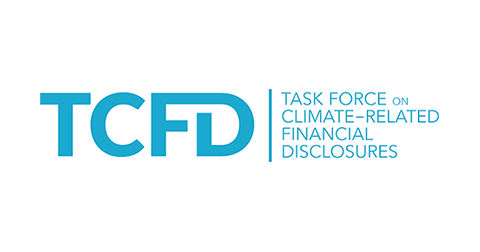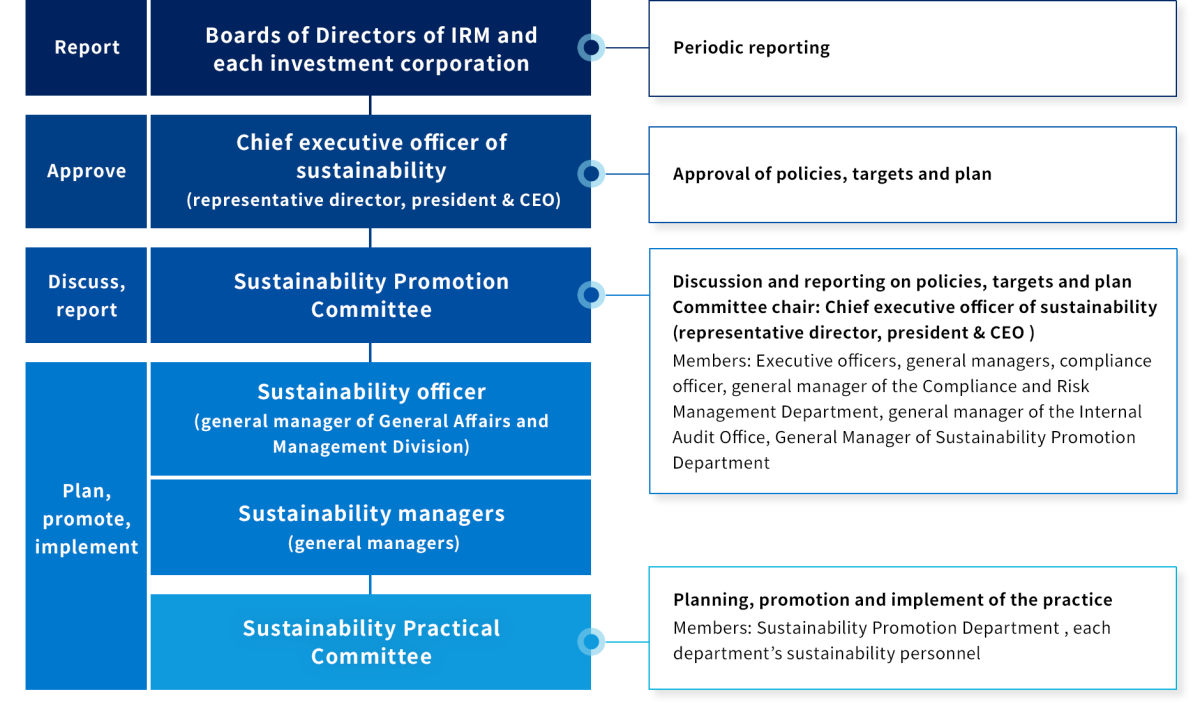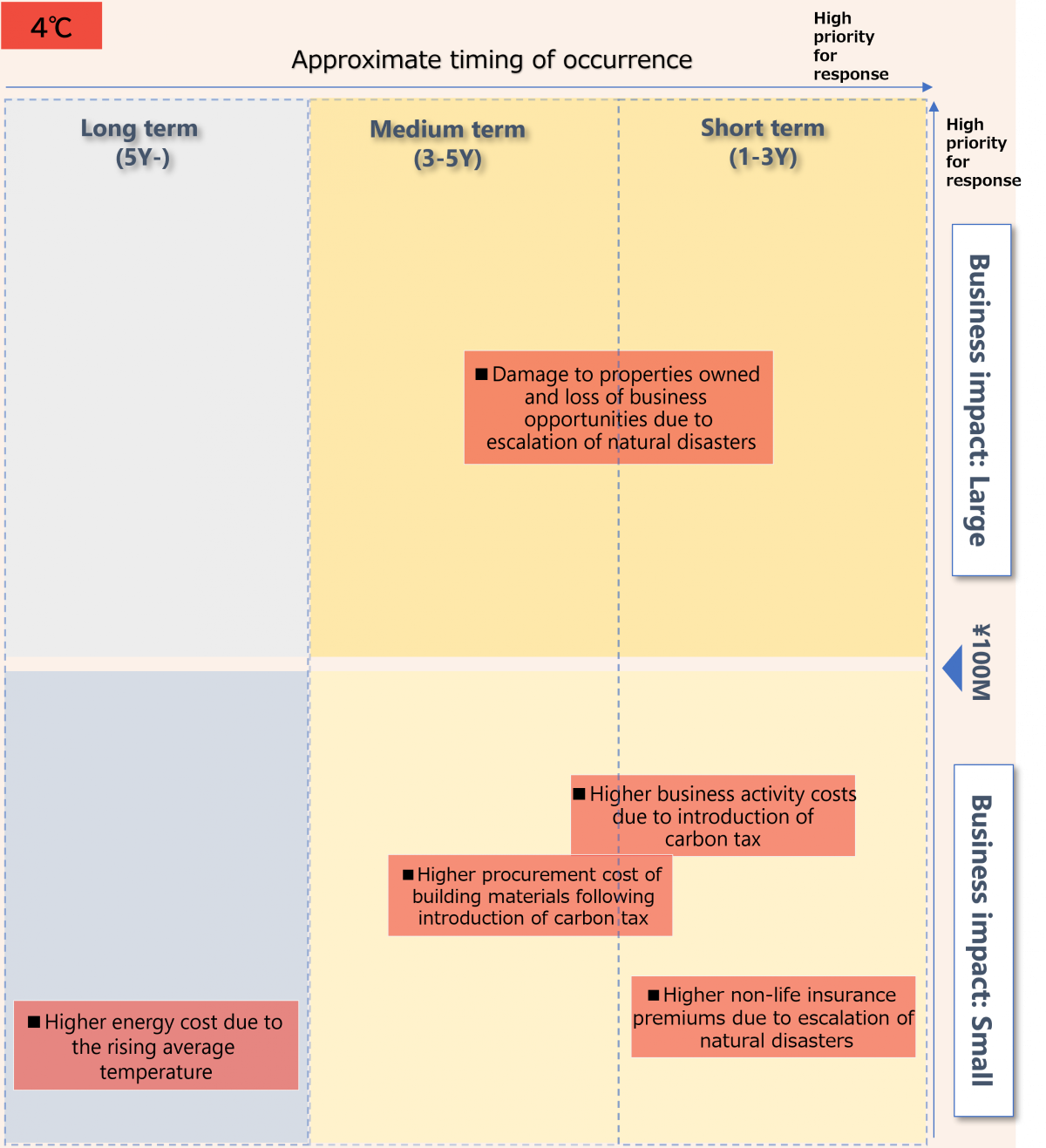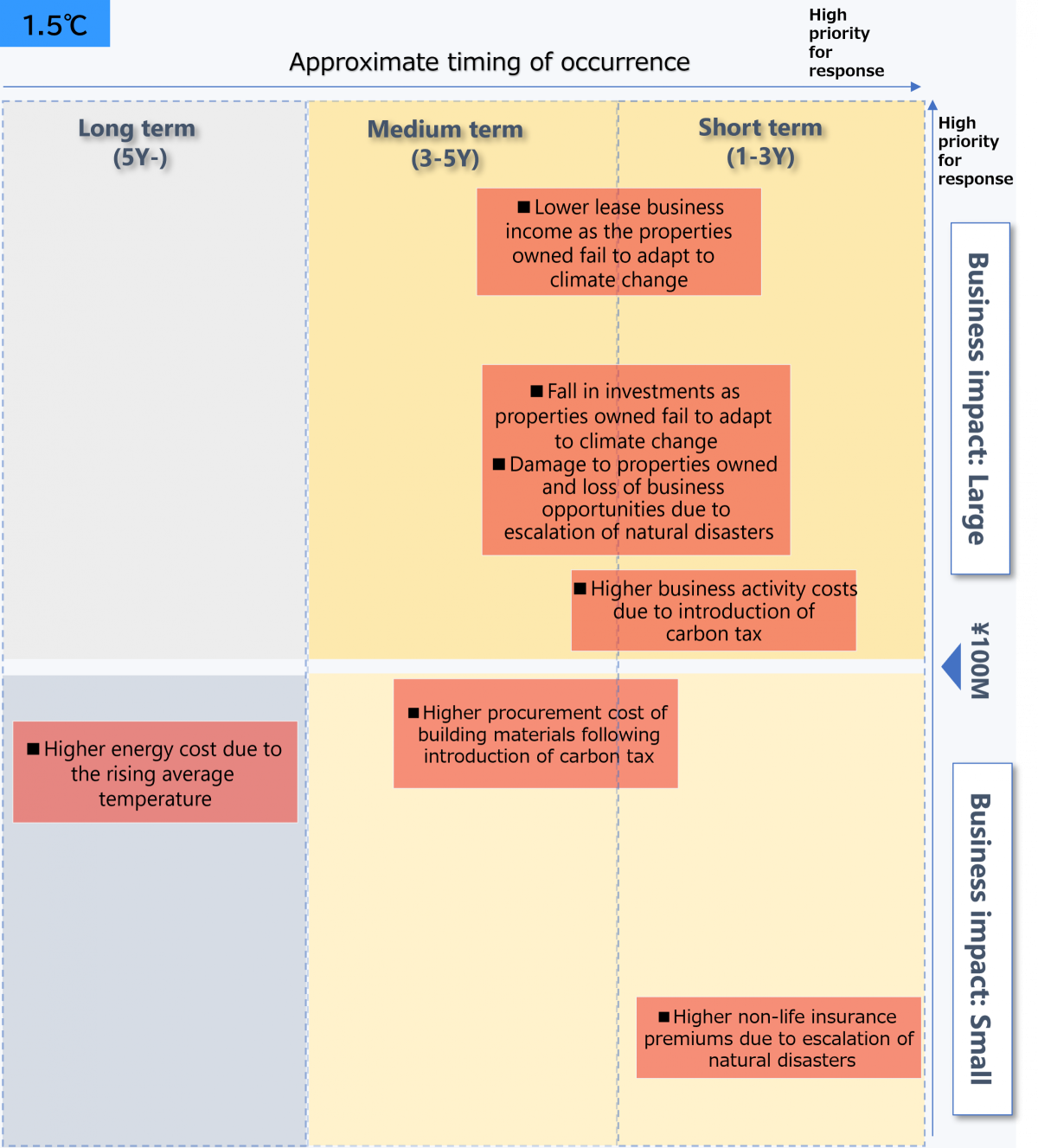Climate Change Initiatives
Climate Change Initiatives
Recognition Regarding Climate Change
Recognizing that climate change is an important challenge that dramatically changes the natural environment and social structure and has a significant impact on all business activities, IRM expressed its support for the recommendations made by the Task Force on Climate-Related Financial Information Disclosures (TCFD) in March 2020. Based on these TCFD recommendations, ADR conducts climate change-related analyses and disclosures under the framework of governance, strategy, risk management, and metrics and targets, to appropriately assess climate change-related risks and opportunities and reflect them in their management and operation policies with the aim of ensuring sustainable and stable income over the long term.
Governance
Management’s roles and oversight by the Boards of Directors of IRM and each investment corporation
- IRM has established the Sustainability Promotion Committee, which is chaired by the representative director, and the Sustainability Practical Committee, which is composed of employees responsible for actual operations in each department.
- The Sustainability Promotion Committee meets at least twice a year to implement a PDCA cycle with the aim of improving asset value over the medium to long term. The PDCA cycle consists of the following steps: formulate sustainability goals and initiatives, identify and evaluate climate-related risks and opportunities, analyze climate-related risks and manage them company-wide, monitor environmental performance as well as the results of ESG evaluation by external organizations, verify the degree of achievement of goals, and reset goals for remaining and new challenges.
- Sustainability goals are set by the representative director, who is the chief executive officer of sustainability, and the progress made toward goals and on initiatives is reported to the Board of Directors of IRM and each investment corporation at least once a year. The Sustainability Practical Committee is responsible for promoting various measures needed to achieve these goals.
Risk Management
Management Process (risk identification and evaluation and integration with company-wide risk management)
- IRM has established the Risk Management Rules and Risk Management Standards as its internal rules to comprehend various risks and opportunities including those related to climate change, to clearly set out our basic approach and internal management structure for such risks and opportunities, and to help ensure the appropriate operation of our business and the soundness of our business management.
- While positioning climate-related risks as having a material impact on the financial and strategical aspects of our business, IRM also sees climate-related risks as opportunities and manages them as part of the company-wide risk management process whereby the Compliance and Risk Management Department gathers information on risks including climate-related risks from other departments, evaluates the degree of their impact, and then identifies company-wide risks following discussions by the management team.
- The Compliance and Risk Management Department reports to the representative director, who is the Chief Executive Officer of IRM, the monitoring status of company-wide risks and opportunities twice a year as well as making reports to IRM’s Compliance Committee and Board of Directors as needed.
Strategy
We classify various change factors in the external environment resulting from climate change into transition risks and physical risks and identify and evaluate them as risks and opportunities. We select any factors that have a material impact on our business and run scenario analysis. We mainly analyze and calculate transition risks related to “policies/regulations, markets, reputation,” and physical risks in the categories of “acute/chronical,” and opportunities related to “markets, energy sources, resource efficiency, products and services.” We aim to reduce our environmental impact while achieving a medium- and long-term growth by addressing climate change-related risks and enhancing our efforts to capture opportunities.
Scenario Analysis
The following chart shows the images of the world surrounding our investment corporations in the climate change scenarios with a 4-degree Celsius temperature rise and 1.5-degree Celsius temperature rise as the background for risk and opportunity identification and evaluation.
Risk and opportunity identification and impact analysis
In order to identify the climate-related risks assumed in scenarios with a 4-degree Celsius temperature rise and 1.5-degree Celsius temperature rise, as well as to understand the priority level of response, ADR has examined the "timing of onset of each risk" and presented it in the following diagram. The "Business Impact" is based on the financial impact of each risk.
*The "Approximate timing of occurrence" indicates the time when each risk is assumed to have a high likelihood of occurrence, as of FY2023, when the analysis was conducted. The timing of occurrence is based on a qualitative consideration of the world view of each scenario based on the advice of a third-party organization, and does not guarantee the accuracy of the timing of occurrence.
Identified risks/opportunities, Countermeasures
The following shows potential climate change-related risks for ADR in the images of the world in the 1.5-degree Celsius and 4-degree Celsius scenarios, their financial impacts, countermeasures, and possible opportunities for ADR’s business.
| Category | Factor | Impact (Risk/Opportunity) |
Financial impact (millions of yen) |
Countermeasures | ||
|---|---|---|---|---|---|---|
| 4℃ | 1.5℃ | Overview | ||||
| Transition risk |
Policies/ |
Tightening of relevant regulations to control CO2 emissions | Higher business activity costs following introduction of carbon tax | 78 | 121 |
|
| Higher procurement cost of building materials following introduction of carbon tax | 62 | 97 |
|
|||
| Reputation | Progress in investments and loans emphasizing climate change actions |
Fall in investments as properties owned fail to adapt to climate change (higher interest rates as preferential interest rates are not applied) |
- | 231 |
|
|
| Markets |
Changing tenants’ demands (Growing needs for properties adapting to climate change) |
Lower lease business income as properties owned fail to adapt to climate change |
- | 1,054 |
|
|
| Physical risk |
Acute |
Escalation of natural disasters such as torrential rain, typhoon, flooding, landslide and high tide; higher risk of wind and water damage |
Damage to properties owned and loss of business opportunities due to escalation of natural disasters |
438 | 219 | |
|
Chronic |
Rising average temperature and escalation of natural disasters |
Higher energy cost due to the rising average temperature |
5 | 86 |
|
|
|
Higher non-life insurance premiums due to escalation of natural disasters |
11 | 5 |
|
|||
| Opportunities |
Resource efficiency |
Strengthening of energy saving-related regulations |
Smaller operating costs due to adoption of energy-saving measures |
|||
|
Products and services |
Changing tenants’ demands |
Higher rent income through provision of low CO2 emissions facilities and services to tenants (higher occupancy and higher rents) |
||||
|
Markets |
Progress in investments and loans emphasizing climate change actions |
Fall in funding cost and increase in investments as actions are taken to address climate change (lower interest rates as preferential interest rates are applied) |
||||
The figures stated as financial impact represent the annual monetary impact. An analysis was conducted on the risks and opportunities of climate change factors that are deemed to have a particularly material impact on ADR’s business activities. Furthermore, the above estimates were calculated based on ADR’s past investment performance, scenarios presented by international organizations and others, and data released by relevant government agencies or other third parties. ADR therefore does not guarantee the accuracy of these figures. The countermeasures listed are also presented for the purpose of calculating the impact; no plan or decision has been made for their implementation.
Metrics and Targets, Results
| Energy consumption | 20% reduction (intensity) by FY2030 (vs. FY2018) |
|---|---|
| CO2 emissions (GHG) | Scope1-2 51% reduction (total) by FY2030 (vs. FY2018) Net zero by FY2050 |







